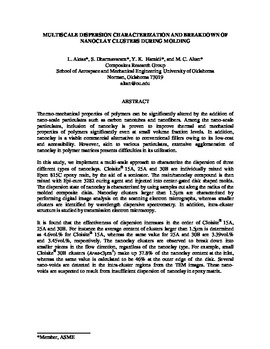| dc.contributor.author | Aktas, L. | |
| dc.contributor.author | Dharmavaram, S. | |
| dc.contributor.author | Hamidi, Y. K. | |
| dc.contributor.author | Altan, M. C. | |
| dc.date.accessioned | 2016-03-23T23:51:50Z | |
| dc.date.accessioned | 2016-03-30T15:36:23Z | |
| dc.date.available | 2016-03-23T23:51:50Z | |
| dc.date.available | 2016-03-30T15:36:23Z | |
| dc.date.issued | 2005 | |
| dc.identifier.citation | Aktas, L, Dharmavaram, S., Hamidi, Y. and Altan, M. C. Multiscale Dispersion Characterization and Breakdown of Nanoclay Clusters during Molding, Presented at the 25th Oklahoma AIAA/ASME Symposium, 2005. | en_US |
| dc.identifier.uri | https://hdl.handle.net/11244/33182 | |
| dc.description.abstract | Thermo-mechanical properties of polymers can be significantly altered by the addition of nano-scale particulates such as carbon nanotubes and nanofibers. Among the nano-scale particulates, inclusion of nanoclay is proven to improve thermal and mechanical properties of polymers significantly even at small volume fraction levels. In addition, nanoclay is a viable commercial alternative to conventional fillers owing to its low-cost and accessibility. However, akin to various particulates, extensive agglomeration of nanoclay in polymer matrices presents difficulties in its utilization.
In this study, we implement a multi-scale approach to characterize the dispersion of three different types of nanoclays. Cloisite® 15A, 25A and 30B are individually mixed with Epon 815C epoxy resin, by the aid of a sonicator. The resin/nanoclay compound is then mixed with Epi-cure 3282 curing agent and injected into center-gated disk shaped molds. The dispersion state of nanoclay is characterized by using samples cut along the radius of the molded composite disks. Nanoclay clusters larger than 1.5µm are characterized by performing digital image analysis on the scanning electron micrographs, whereas smaller clusters are identified by wavelength dispersive spectrometry. In addition, intra-cluster structure is studied by transmission electron microscopy.
It is found that the effectiveness of dispersion increases in the order of Cloisite® 15A, 25A and 30B. For instance the average content of clusters larger than 1.5µm is determined as 4.6vol.% for Cloisite® 15A, whereas the same value for 25A and 30B are 3.39vol.% and 3.45vol.%, respectively. The nanoclay clusters are observed to break down into smaller pieces in the flow direction, regardless of the nanoclay type. For example, small Cloisite® 30B clusters (Area<3µm2) make up 37.8% of the nanoclay content at the inlet, whereas the same value is calculated to be 46% at the outer edge of the disk. Several nano-voids are detected in the intra-cluster regions from the TEM images. These nano-voids are suspected to result from insufficient dispersion of nanoclay in epoxy matrix. | en_US |
| dc.language | en_US | en_US |
| dc.subject | Nanoclay composites | en_US |
| dc.title | Multiscale Dispersion Characterization and Breakdown of Nanoclay Clusters during Molding | en_US |
| dc.description.peerreview | Yes | en_US |
| dc.description.peerreviewnotes | Peer reviewed and presented at the 25th Oklahoma AIAA/ASME Symposium. | en_US |
| ou.group | College of Engineering::School of Aerospace and Mechanical Engineering | en_US |
